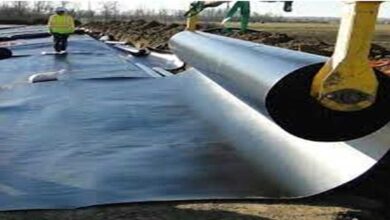How HDPE Geomembranes are Revolutionizing Waste Management
In recent years, High-Density Polyethylene (HDPE) geomembranes have emerged as a game-changing technology in the field of waste management. These innovative materials are transforming how we handle, contain, and process waste, offering unprecedented levels of environmental protection and operational efficiency. This revolution is particularly evident in regions like the United Arab Emirates (UAE), where HDPE Geomembrane UAE applications are at the forefront of modern waste management practices.
The Waste Management Challenge
Waste management has long been a critical environmental and public health concern worldwide. Traditional waste disposal methods often lead to soil and groundwater contamination, greenhouse gas emissions, and other environmental hazards. As populations grow and urbanization accelerates, the need for more effective and sustainable waste management solutions has become increasingly urgent.
Enter HDPE Geomembranes
HDPE geomembranes are synthetic liner materials that provide an impermeable barrier between waste and the surrounding environment. Their unique properties make them ideal for various waste management applications:
- Exceptional Chemical Resistance: HDPE geomembranes can withstand exposure to a wide range of chemicals, making them suitable for containing diverse types of waste.
- High Tensile Strength: These materials can bear significant loads without tearing or puncturing, ensuring long-term integrity.
- Flexibility: HDPE geomembranes can conform to irregular surfaces, providing comprehensive coverage in landfills and other waste containment structures.
- Low Permeability: They effectively prevent the migration of liquids and gases, crucial for containing leachate and landfill gases.
- UV Resistance: Specially formulated HDPE geomembranes can withstand prolonged exposure to sunlight, particularly important in regions like the UAE with high solar radiation.
Revolutionizing Landfill Design
One of the most significant impacts of HDPE geomembranes has been in landfill design and operation:
- Leachate Management: HDPE geomembranes form an impermeable barrier that prevents leachate (liquid that has passed through waste) from contaminating soil and groundwater. This is crucial in protecting local ecosystems and water resources.
- Gas Containment: Landfill gases, primarily methane and carbon dioxide, are major contributors to greenhouse gas emissions. HDPE geomembranes help contain these gases, allowing for their collection and potential use as an energy source.
- Increased Capacity: The strength and flexibility of HDPE geomembranes allow for steeper side slopes in landfills, increasing their capacity without expanding their footprint.
- Extended Lifespan: With proper installation and maintenance, HDPE geomembranes can last for decades, significantly extending the operational life of landfills.
- Regulatory Compliance: The use of HDPE geomembranes helps waste management facilities meet stringent environmental regulations, including those in the UAE.
Enhancing Waste Treatment Facilities
Beyond landfills, HDPE geomembranes are revolutionizing other aspects of waste management:
- Composting Facilities: HDPE geomembranes are used to line composting pads, preventing nutrient-rich runoff from contaminating surrounding areas.
- Anaerobic Digestion Plants: These facilities use HDPE geomembranes to line digestion tanks, ensuring the containment of organic waste and biogas during the decomposition process.
- Waste-to-Energy Plants: HDPE geomembranes play a crucial role in lining ash landfills associated with waste-to-energy facilities, preventing the leaching of potentially harmful substances.
- Hazardous Waste Storage: The chemical resistance of HDPE geomembranes makes them ideal for lining hazardous waste storage areas, providing an additional layer of safety.
HDPE Geomembrane UAE: A Case Study in Innovation
The UAE has been at the forefront of adopting HDPE geomembranes in its waste management practices. Several factors contribute to this trend:
- Rapid Urbanization: As UAE cities expand, the need for efficient and environmentally sound waste management solutions has grown.
- Environmental Consciousness: The UAE’s commitment to sustainable development has driven the adoption of advanced waste management technologies.
- Harsh Climate: The UAE’s hot and arid climate necessitates materials that can withstand extreme temperatures and UV radiation, making HDPE geomembranes an ideal choice.
- Regulatory Framework: Stringent environmental regulations in the UAE have encouraged the use of high-performance containment solutions like HDPE geomembranes.
Economic and Environmental Benefits
The adoption of HDPE geomembranes in waste management offers numerous benefits:
- Cost-Effectiveness: While the initial investment may be higher, the longevity and low maintenance requirements of HDPE geomembranes result in significant long-term cost savings.
- Reduced Environmental Impact: By preventing contamination and containing emissions, HDPE geomembranes help minimize the environmental footprint of waste management operations.
- Resource Recovery: The effective containment provided by HDPE geomembranes facilitates the collection and potential utilization of landfill gases and leachate.
- Land Conservation: The increased efficiency of landfills lined with HDPE geomembranes means less land is required for waste disposal.
- Public Health Protection: By preventing the spread of contaminants, HDPE geomembranes play a crucial role in safeguarding public health.
Challenges and Future Developments
Despite their many advantages, the use of HDPE geomembranes in waste management is not without challenges:
- Installation Expertise: Proper installation is crucial for the effectiveness of HDPE geomembranes, requiring specialized skills and equipment.
- Quality Control: Rigorous quality control measures are necessary to ensure the integrity of HDPE geomembrane installations.
- End-of-Life Management: While HDPE geomembranes have a long lifespan, eventual replacement and disposal must be considered in long-term planning.
Looking to the future, several developments are likely to further enhance the role of HDPE geomembranes in waste management:
- Smart Geomembranes: Integration of sensors for real-time monitoring of liner integrity and performance.
- Enhanced Formulations: Ongoing research into improving UV resistance, chemical compatibility, and overall durability.
- Recycling Innovations: Development of more efficient methods for recycling used HDPE geomembranes, contributing to circular economy principles.
- Integration with Other Technologies: Combining HDPE geomembranes with other waste management technologies for more comprehensive solutions.
Conclusion
HDPE geomembranes are undeniably revolutionizing waste management practices globally, with significant adoption in regions like the UAE. By providing superior containment, extending facility lifespans, and enabling more efficient operations, these materials are playing a crucial role in addressing the complex challenges of modern waste management. As technology continues to evolve and environmental concerns remain at the forefront, the importance of HDPE geomembranes in creating sustainable, safe, and efficient waste management systems is set to grow even further.



